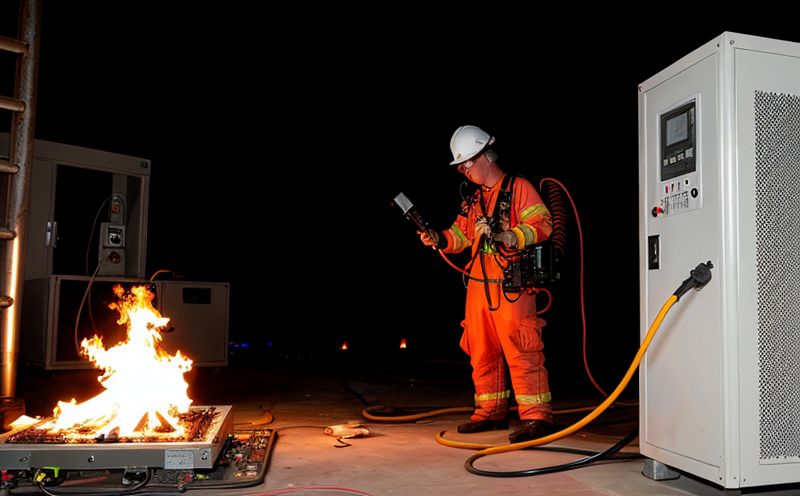Fire Propagation Testing on Electrical Cables
In today’s interconnected world, electrical and electronic equipment play a pivotal role in our daily lives. However, when these components malfunction or are exposed to fire hazards, the consequences can be devastating. Fire propagation testing on electrical cables is an essential step in ensuring that products meet stringent safety standards and comply with international regulations.
The primary aim of this test is to assess how quickly and intensely a flame will spread along the length of an electrical cable when exposed to fire. This information is crucial for manufacturers, quality managers, R&D engineers, and procurement officers who need to ensure that their products are safe not only during normal use but also in case of accidental ignition.
The test typically involves subjecting a sample of the electrical cable to controlled conditions where it is exposed to a source of flame. The duration of exposure can vary depending on the standard being followed, such as IEC 60332 or UL 1581. After the flame application, various parameters are measured including the time taken for the fire to propagate along the cable and the maximum temperature reached.
Understanding these metrics helps manufacturers design safer products that can withstand accidental ignition without compromising on performance. By conducting rigorous fire propagation tests, companies ensure they meet global safety standards set by organizations like Underwriters Laboratories (UL) and the International Electrotechnical Commission (IEC).
The results of such tests are critical for ensuring compliance with regulations across various industries including automotive, aerospace, and construction where electrical wiring is crucial. These tests help identify potential weaknesses in cable design early on, allowing manufacturers to make necessary improvements before products reach the market.
| Parameter | Description |
|---|---|
| Cable Type | The specific type of electrical cable being tested (e.g., PVC, XLPE). |
| Flame Application Method | The method used to apply the flame to the specimen. |
| Temperature Measurement | The maximum temperature reached during the test. |
| Cross-Sectional Area | The cross-sectional area of the cable being tested. |
Why It Matters
The importance of fire propagation testing on electrical cables cannot be overstated. As society becomes increasingly reliant on technology, so too does our exposure to potential hazards associated with faulty or inadequately tested equipment. A single failure in an electrical component could lead to widespread fires and casualties.
By incorporating rigorous testing into the development process, manufacturers can significantly reduce these risks. Not only do they protect consumers from harm but also safeguard their own reputation and legal standing against product liability claims. This proactive approach fosters trust between companies and customers while enhancing overall market confidence in electrical products.
In addition to protecting end users, fire propagation testing plays a vital role in ensuring that manufacturers comply with international standards such as IEC 60332-1 and UL 752. These guidelines provide specific criteria for evaluating the flame retardancy properties of different cable types under controlled conditions.
Compliance with these standards is not only a requirement but also an opportunity for businesses to demonstrate their commitment to safety and quality assurance. It allows them to enter new markets where stringent regulations exist without fear of non-compliance penalties or recalls.
Industry Applications
| Sector | Application Details |
|---|---|
| Aerospace | Evaluating the suitability of wiring systems for use in aircraft interiors. |
| Automotive | Ensuring passenger safety by testing fire resistance of vehicle wiring harnesses. |
| BUILDING AND CONSTRUCTION | Evaluating the performance of electrical conduits and cable assemblies in building structures. |
The results from fire propagation tests are particularly valuable for industries where electrical systems form a critical part of operations. For instance, aerospace companies must ensure that their aircraft interiors remain safe even if a fire breaks out due to short circuits or other malfunctions.
Similarly, automotive manufacturers rely on these tests to verify the integrity of vehicle wiring harnesses which run through various parts of the car including the engine bay and passenger compartment. In construction projects involving large-scale buildings like shopping malls or office complexes, ensuring that electrical conduits can withstand fire is crucial for preventing catastrophic failures.
Across all sectors, the outcome of these tests directly impacts public safety by reducing the likelihood of fires caused by faulty electrical components. This makes it an indispensable part of any quality assurance program aimed at enhancing product reliability and user confidence.
Why Choose This Test
Selecting fire propagation testing on electrical cables is a wise decision for several reasons. Firstly, it provides valuable insights into the behavior of your product under extreme conditions which may not be apparent during routine inspections.
Secondly, by adhering to recognized standards such as IEC 60332-1 or UL 752, you ensure that your products meet industry-wide benchmarks for electrical safety. This can open up opportunities for international trade and collaboration with other firms who also follow these guidelines.
Additionally, regular testing helps maintain a high level of quality control within your organization. It allows you to identify any issues early on during the development phase rather than discovering them only after the product has been released into the market. Early detection enables swift corrective actions to be taken before they become more serious problems.
Finally, conducting fire propagation tests demonstrates a strong commitment to safety and compliance with regulations. In today’s competitive marketplace, this can be a key differentiator that sets your products apart from competitors’ offerings. It builds consumer trust and fosters long-term relationships between suppliers and buyers alike.





